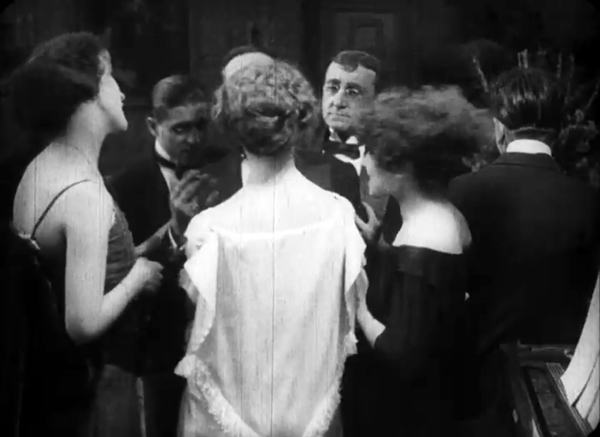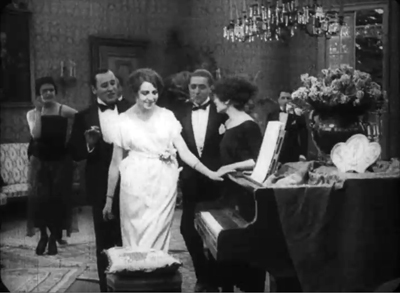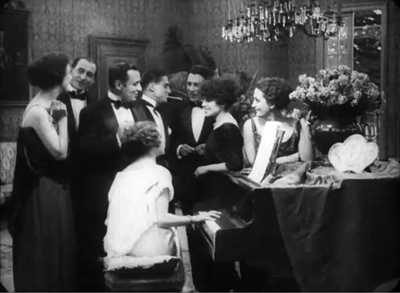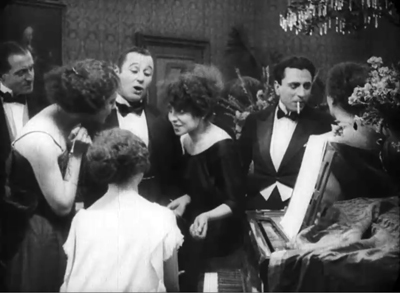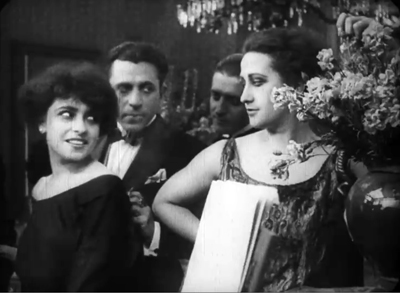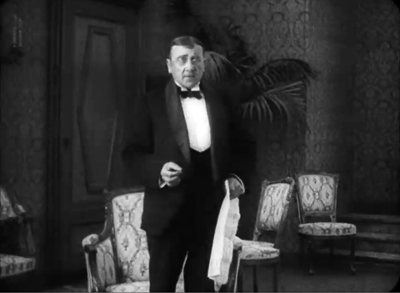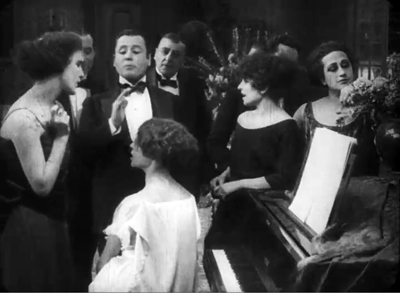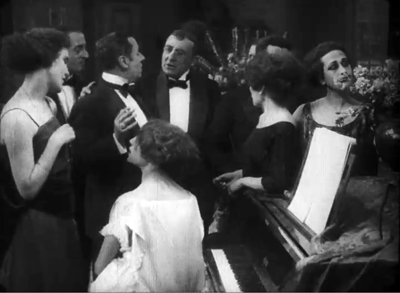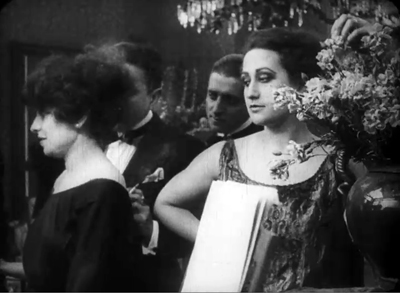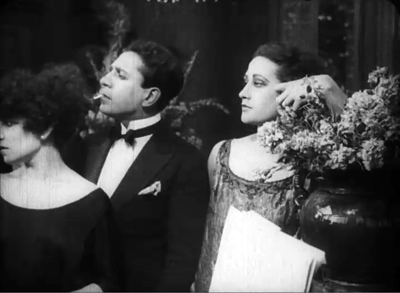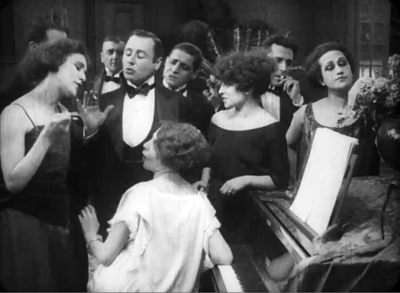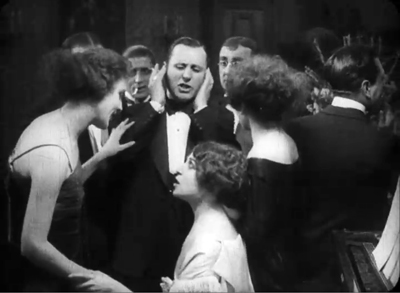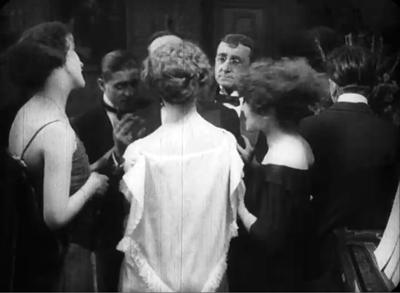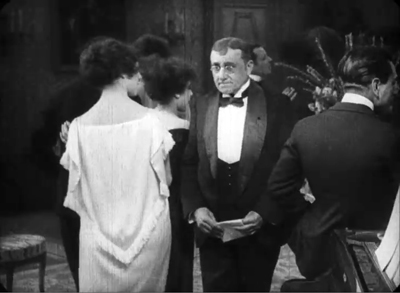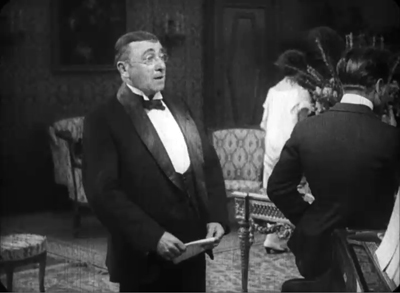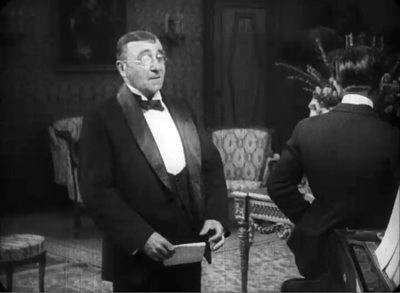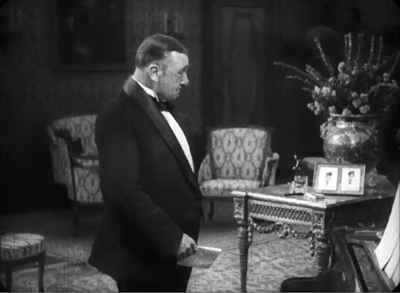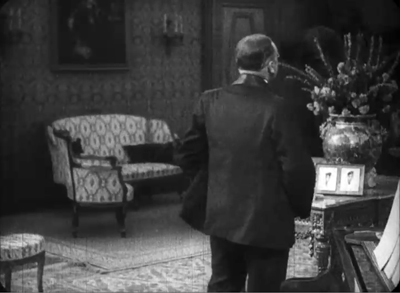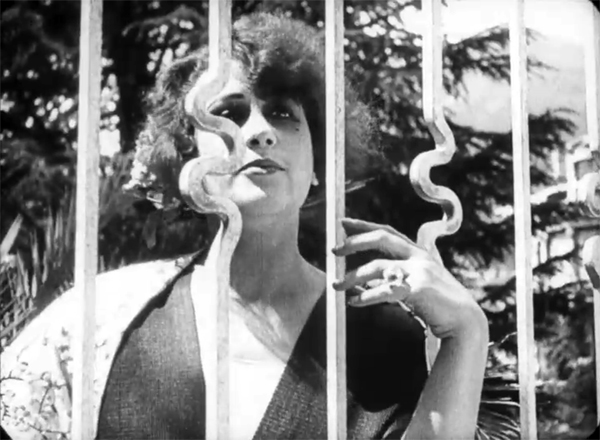Il Maschera e il Volto (1919).
…can crisply punctuate a scene.
DB here:
One of the 1919 films on display at Cinema Ritrovato [2] this year was Augusto Genina’s Il Maschera e il Volto (The Mask and the Face, 1919). It’s drawn from a popular play that satirized the erotic stratagems of the elite. The movie begins by introducing a gaggle of couples at a Lake Como house party, so I expected that it would create interlocking intrigues in the manner of silent-era Lubitsch films like The Marriage Circle (1924). Not so: the plot concentrates on one romantic triangle. The version we have, at 1799 meters, might be a little shorter than the original (said to be around 1900 meters), but it seems likely that the plot we have dominated the initial release too.
Savina is betraying her husband Paolo with the family lawyer Luciano. During the house party Paolo declares that a cuckolded husband has every right to murder the unfaithful wife. When he learns of Savina’s affair (but not Luciano’s complicity), he orders her to leave the household immediately. Paolo declares that she will become dead to him and their friends.
Paolo tells Luciano that he killed Savina. We get a lying flashback (yep, already and again [3]) that shows him strangling her and dumping her body in the lake. Savina overhears his false confession. When she hears Luciano asserts that she got what she deserved, she realizes he’s worthless. Disillusioned about both of the men in her life, she follows Paolo’s order and leaves their estate.
Of course a woman’s corpse, face mutilated, is soon found in the lake. Now Paolo must stand trial for Savina’s murder, and Luciano must defend him.
Not the funniest comedy I ever saw, but it has a grim charm. One particular scene made me happy.
Piano ensemble
Readers of this blog know that I like to study staging [4] in 1910s films [5], and Genina provided nifty examples [6] in the 2017 Ritrovato season. Like the Lupu Pick film [7] I reviewed at this year’s jamboree, Il Maschera lies stylistically midway between pure tableau cinema and editing-driven construction. Interior scenes are often broken up by many cuts, but they’re typically axial, straight-in and straight-back, without reverse angles. (The exception is the trial scene. As in many 1910s films, it creates a more immersive space through “all-over” cutting.) In most scenes, the shots enlarge actors to follow their responses, but we don’t get setups that penetrate the space, putting us inside the flow of action.
Still, axial cuts, as Eisenstein and Kurosawa and John McTiernan [8] knew, have a peculiar power. They can be abrupt and punchy, or more subtle in readjusting the framings. The latter option is on display in the film’s first big scene, when all the guests gather in the salon around the piano.
The scene runs about two and half minutes and consists of twelve shots and six dialogue titles. What’s worth noticing is the slight variations in setups, coordinated with what Charles Barr has felicitously called “gradation of emphasis.” [9]Often the changing setups are masked by an inserted dialogue title, so there are no bumps in continuity.
The orienting view is a bustling shot that piles up faces and shoulders along the horizontal axis.
In an axial cut-in, the guests debate the righteousness of Othello’s murder of Desdemona. A further cut-in shows Luciano and Savina on the far right sharing glances. (The curly-haired woman will prove an innocent witness.) It’s a Hitchcockian situation, but without the POV singles.
Soon an older husband rises from his chair in the rear (another cut-in, “through” the group) and comes forward to join them. He draws alongside the husband to calm him down.
I’ve talked about crowded tableaus like this before. [17] The Americans I survey were somewhat bolder than Genina in jamming the heads even closer together, creating partial faces that float out of the background. Genina has, however, other goals in view.
The woman in white
During the cut-ins, Genina takes the opportunity to rearrange the actors around the piano and re-scale his shots. There are five distinct variants of the piano grouping; even setups that might seem the same aren’t quite. There are two setups of the adulterous couple. All these are calibrated to suit the action presented.
For instance, when Paolo launches his rant about unfaithful women, the framing is tighter to favor him, and the foreground woman in white is primed for her big moment.
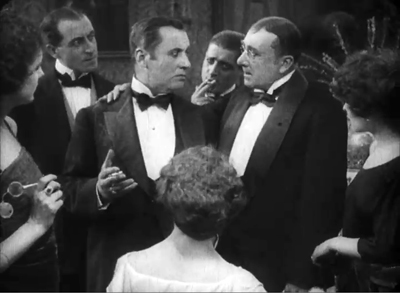
Similarly, the second cut to the adulterous couple is framed somewhat differently from the earlier one (on left), with Luciano pushing aside the cute curlyhead. He and Savina are listening more intently to Paolo’s denunciation of faithless wives.
So what seem to be fairly straightforward repetitions of setups are in fact minutely adjusted to favor certain actions. This strategy allows Genina to return to the whole ensemble.
In a closer view, the woman in white suggests that they stop arguing about infidelity and go in to play cards. She rises, blotting out Paolo in mid-rant.
The effect would be less pointed if she were in black like the other women.
Everyone but the older husband turns away, and people retire to the next room in the distance. They drain the space like water emptying out of a tub. That leaves what filmmakers today would call the scene’s button: the old man noticing that Luciano and Savina don’t join the group. Throughout the scene they’ve been literally marginalized on the far right.
It’s through this older man we just barely see the couple leave. He seems to understand the game they’re playing. and now he watches them disappear, perhaps to a private rendezvous.
The scene ends with another turning from the camera, another actor’s back letting us know the action is done.
Very often, turning from the camera [28] signals the end of scenes, and of films.
It would have been fairly easy for any director to simply let the actors clustered around Paolo drag him off to play cards. But by having the woman in the foreground pop up, cut off our view of Paolo, and trigger a general exit Genina makes the action taper off briskly. Staging in the silent cinema is full of such little felicities, and it’s one job of criticism to appreciate them. It’s especially important since such techniques seem no longer part of filmmakers’ skill sets.
Then again, some Maschera images just whack you in the eye. Who doesn’t sense passion, elaborately caged, in the image below?
Thanks as usual to the Cinema Ritrovato Directors: Cecilia Cenciarelli, Gian Luca Farinelli, Ehsan Khoshbakht, Mariann Lewinsky, and their colleagues. We particularly owe Mariann for her curating of the Hundred Years Ago series every year. Special thanks as well to Guy Borlée, the Festival Coordinator.
Information about La maschera e il volto can be found in Vittorio Martinelli’s Il Cinema Muto Italiano: I film del dopogerra/1919 (Rome: Bianco et nero, 1960), 170-172.
Other Sometimes... entries consider a single axial cut [29], a shot in depth [30], a jump cut [31], a reframing [32], and a production still [33].
Il Maschera e il Volto (1919).
